For any busy person or child, calf-tightening techniques are nothing short of a nightmare. If you are an athlete, a weekend warrior, or more of a sit-at-work-guy, tight calves can spoil your comfort and range of motion, as well as lead to other issues such as lower back pain and plantar fasciitis. If you, however, know what causes calf tightness, what to do to ease that tension, and what the best stretches are, your calves shall remain free and loose, hopefully preventing future injury.
What Causes Calves to be Tight?
There are numerous causes of tight calves, and they can be different based on your medical conditions, activity level, and lifestyle.
Overuse Exercise
Repetitive exercise such as running, cycling, or sports involving contact tends to cause tight calves after exercise. Tightness occurs when muscles get fatigued and are not rested or stretched.
Lack of Proper Warm-Up or Cool-Down
Lack of exercise or stretching after work is also one of the major reasons for calf muscle tightness. Muscles need rest and readiness in order to remain loose.
Insufficient Exercise
Unbeknownst to you, calf tightness is also caused by too much inactivity. You develop calf muscles to tighten up if you spend too much time sitting down, and when you get up to move around, they tighten.
Poor Shoes
Wearing ill-fitting shoes or heels slants your ankles' and legs', and hence constricts your calf muscles.
Muscle Imbalance or Injury
Damage, muscle imbalance, or tension in surrounding tissues like hamstrings or hips may cause overloading of your calf muscles.
Symptoms of Tight Calfs
One must know the tight calf muscle symptoms, and one must treat them early. The most common symptoms include:
- Perception of tightness or heaviness in calves
- tight calves when walking or running
- Reduced range of motion of foot or ankle
- Spasm with effort or on rest
- Pain or burning pain in calf stretch
In others, tight calves and lower back pain or tight calves and plantar fasciitis may arise due to compensatory movement patterns.
Immediate Relief Tips for Tight Calves
If you’re struggling with calf tightness, here are some quick relief strategies:
Gentle Stretching
Do easy stretching tight calves to assist with circulation and reduce stiffness. Hold the stretches for at least 30 seconds and repeat 2-3 times a day.
Foam Rolling
Foam rolling of muscle calves with knots is utilized to unwind knotted sites of the muscle and help in enhanced blood flow. Slowly roll over the muscle, and at painful places, stop for a maximum of 60 seconds.
Heat Therapy
A warm compress or shower will ease tension and enable muscles to relax.
Hydration and Electrolyte Balance
Dehydration aggravates calf muscle stiffness. Give enough water and restore electrolytes after an episode of exercise.
Massage
Self- or occupation massage for tight calves of spastic calf relaxes and relieves tension. Apply firm, static pressure, moving upward on the leg to the knee.
Best Calf Stretches for Flexibility
Maintenance stretching loosens calf muscle and prevents tightness. Some good stretchers are as follows:
Standing Calf Stretch
- Stand facing a wall.
- Step out with one foot and bent knee and stand on the other leg straight behind.
- Keep the heel of the back on the floor and press into the wall.
- Hold for 30 seconds and switch to the other side.
Downward Dog
- Stretches calf, back, and hamstrings.
- Begin on feet and hands, press hips back and up into inverted V-position.
- Press lightly down on heels towards ground.
- Let 30-60 seconds.
Seated Calf Stretch with Towel
- Sit on floor with legs straight out in front of you.
- Wrap towel around ball of foot and pull towel in toward body.
- Hold with locked knee 30 seconds.
Heel Drop Stretch
- Stand on step with heels hanging over edge of step.
- Dangle heels down, lock knees.
- Repeat and hold for 30 seconds.
Foam Rolling
While not a stretch, foam rolling tight calves muscles both pre- and post-stretching makes your stretching exercise more effective.
Long-Term Prevention and Treatment
If long-term interventions do succeed in preventing chronic calf tightness problems from occurring:
- Strength Training: Do calf exercises to stretch and strengthen tight calf muscles. Some examples of exercises for tight calves include calf raises, toe walking, or resistance bands.
- Regular Stretching: Regular calf and corresponding muscle like hamstrings and hips stretching maintains them as flexible as possible and in a perfect balance.
- Suitable Footwear: Wear a shoe that is supportive of the arch and cushioned, particularly for sport or standing for periods of time.
- Gradual Exercise: Increase the amount and duration of exercises slowly to allow your muscles to acclimatize.
- Active Recovery: Swim or practice yoga in your workweek to include recovery and flexibility.
When to Refer a Professional?
- Recurrent or severe calf tightness
- Pain on exercising or not resolving with rest
- Calf strain or tear symptom
- Functional deficit and hypertonic calf
You should consult a doctor or physiotherapist. They are capable of screening for nerve, vascular, or biomechanical dysfunction causing compression disorder of the nerve, tight calves while running, or tight walking calf. A practitioner can prescribe the treatment in one specific mode, proper exercises, or a mode based on the cause and not symptoms.
Conclusion
A cramped calf muscle is one of the irritating conditions one can encounter, and, in its untreated state, will later on, develop into more disabling conditions that will bring about decreased mobility, vulnerability to injury, and pain. Through exercise, activities of daily living, or biomechanics, one should learn how to relax those tight muscles in the calves and avoid stiffness in the process of maintaining a healthy muscle.
A potent mixture of emergency stretches, daily stretches and strengthening exercises, and professional treatment whenever you need it will keep your calf muscles loose, functional, and free of pain. Don't dismiss the signals emanating from your body; consider those tight calf muscles just the beginning, and everything else will flow from there as you rejoice in free movement and comfort for the rest of your daily life.
Please book an appointment with the
best Physiotherapist in Lahore, Karachi, Islamabad, and all major cities of Pakistan through
InstaCare, or call our helpline at 03171777509 to find the verified doctor for your disease.

